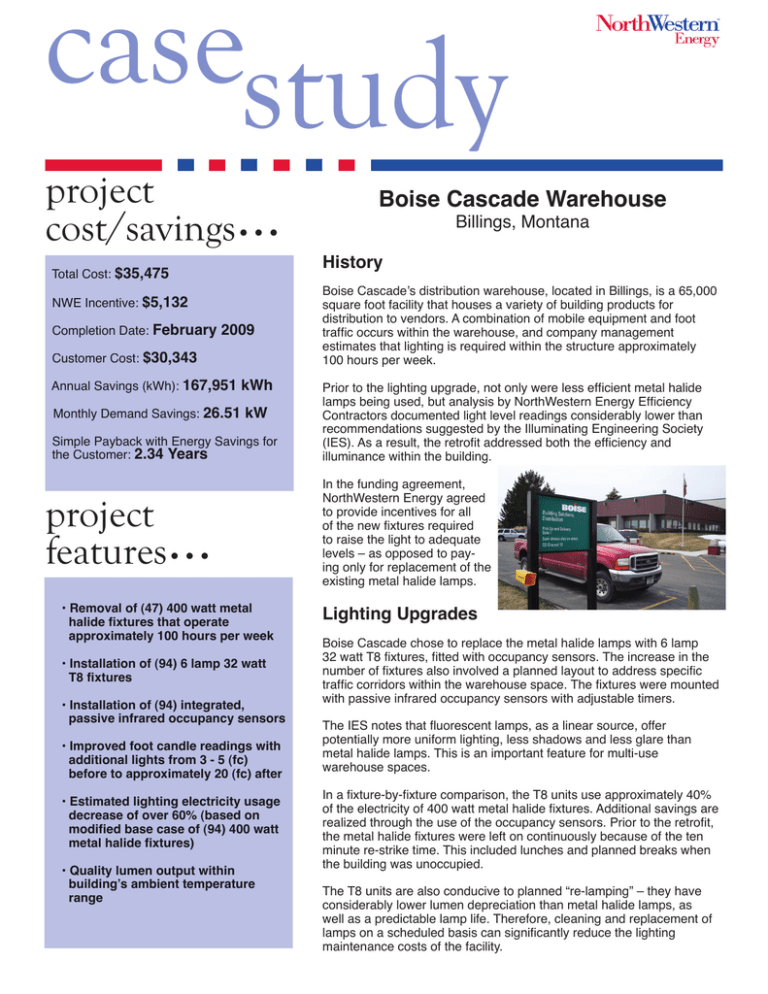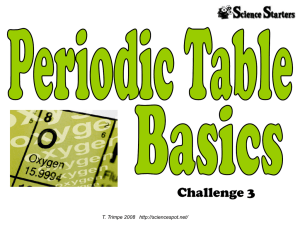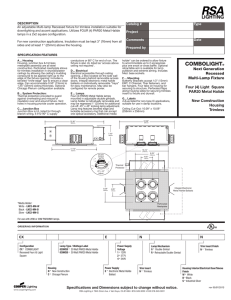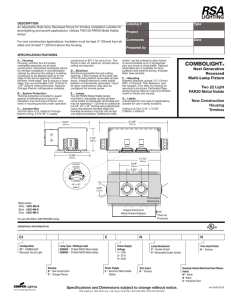Boise Cascade warehouse, lighting upgrade
advertisement

casestudy project cost/savings••• Billings, Montana History Total Cost: $35,475 NWE Incentive: $5,132 Completion Date: February Boise Cascade Warehouse 2009 Customer Cost: $30,343 Annual Savings (kWh): 167,951 kWh Monthly Demand Savings: 26.51 kW Simple Payback with Energy Savings for the Customer: 2.34 Years project features••• • Removal of (47) 400 watt metal halide fixtures that operate approximately 100 hours per week • Installation of (94) 6 lamp 32 watt T8 fixtures • Installation of (94) integrated, passive infrared occupancy sensors • Improved foot candle readings with additional lights from 3 - 5 (fc) before to approximately 20 (fc) after • Estimated lighting electricity usage decrease of over 60% (based on modified base case of (94) 400 watt metal halide fixtures) • Quality lumen output within building’s ambient temperature range Boise Cascade’s distribution warehouse, located in Billings, is a 65,000 square foot facility that houses a variety of building products for distribution to vendors. A combination of mobile equipment and foot traffic occurs within the warehouse, and company management estimates that lighting is required within the structure approximately 100 hours per week. Prior to the lighting upgrade, not only were less efficient metal halide lamps being used, but analysis by NorthWestern Energy Efficiency Contractors documented light level readings considerably lower than recommendations suggested by the Illuminating Engineering Society (IES). As a result, the retrofit addressed both the efficiency and illuminance within the building. In the funding agreement, NorthWestern Energy agreed to provide incentives for all of the new fixtures required to raise the light to adequate levels – as opposed to paying only for replacement of the existing metal halide lamps. Lighting Upgrades Boise Cascade chose to replace the metal halide lamps with 6 lamp 32 watt T8 fixtures, fitted with occupancy sensors. The increase in the number of fixtures also involved a planned layout to address specific traffic corridors within the warehouse space. The fixtures were mounted with passive infrared occupancy sensors with adjustable timers. The IES notes that fluorescent lamps, as a linear source, offer potentially more uniform lighting, less shadows and less glare than metal halide lamps. This is an important feature for multi-use warehouse spaces. In a fixture-by-fixture comparison, the T8 units use approximately 40% of the electricity of 400 watt metal halide fixtures. Additional savings are realized through the use of the occupancy sensors. Prior to the retrofit, the metal halide fixtures were left on continuously because of the ten minute re-strike time. This included lunches and planned breaks when the building was unoccupied. The T8 units are also conducive to planned “re-lamping” – they have considerably lower lumen depreciation than metal halide lamps, as well as a predictable lamp life. Therefore, cleaning and replacement of lamps on a scheduled basis can significantly reduce the lighting maintenance costs of the facility. T8 Lamps as Replacements for Metal Halides Metal halide lamps can emit up to 36,000 initial lumens, but many factors must be included when calculating the “useful” light of the lamp and fixture. The fixture body most frequently used in metal halide applications is characterized by a spun reflector and lens. This configuration leads to an overall fixture efficiency of between 60 and 70%. Comparatively, T8 high bay fixtures usually have between 80 and 90% fixture efficiency. Of primary importance when comparing metal halides to T8s is the lumen depreciation. Metal halide lamps experience a steep depreciation in the first 40% of their life, followed by a steady decline until the end of the lamp’s life. Conversely, T8 lamps experience only a 5-7% depreciation during the lamp’s life. After approximately 4,000 hours, most 6 lamp T8 fixtures produce more lumens than 400 watt metal halide lamps. Lumen Depreciation Comparison The Boise Cascade warehouse is similar to other industrial and agricultural buildings in Montana that are insulated, but not heated. Except in extreme weather conditions, the interior temperature of the building does not drop below freezing. Most higher quality T8 lamp and ballast combinations start down to 0˚ F without the need for a costly, cold weather ballast. The T8 units work well in the most common temperature environments found within insulated warehouse spaces (50-80˚ F.) - and they have lower lumen losses up to 77˚ F when compared to T5 HO lamps. Metal Halide vs T8 Fluorescent Lamps 40,000 Total Lumen Output other potential applications••• 30,000 T8 Six-Lamp Fixture 20,000 400W Metal Halide 10,000 Source: U.S. Department of Energy 28,000 24,000 20,000 16,000 12,000 8,000 0 4,000 0 Hours of Operation 6 lamp T8 fixtures also have a more natural color rendering index than metal halide lamps, and provide slightly more foot candle output below and between fixtures. T8 lamps operate well in warehouse applications where inside temperatures may be lower (similar to the Boise Cascade application). This is due to the fact that T8s provide peak output at 77 degrees F. The Correct Amount of Light project contacts and resources ••• Building Owner: Boise Cascade Shawn Egan (406) 652-3250 A common misconception that leads to inefficient and/or ineffective lighting is that more light translates into higher quality light. An audit and consultation with NorthWestern Energy Efficiency Contractors addresses not only efficiency, but also quantity and quality. Part of the process is to determine the appropriate light levels for an area; an exercise that showed deficiencies in Boise Cascade’s original lighting design. NorthWestern Energy E+ Contractors: KEMA, Mike Horner (800) 823-5995 Measured in foot candles, the IES recommends the following levels: Pioneer Technical, Mitch Mihailovich (406) 782-5177 Application Application Application Reading/Writing - 50 fc Stockrooms - 10 fc Retail (Low Volume) - 30 fc Office Ambient - 25 fc Loading Docks - 10 fc Roadways - .3 - 1.6 fc Office Task - 25 fc Rough Warehouse - 10-20 fc Parking Lots - .8 - 3.6 fc Hallways - 10 fc Retail (High Volume) - 100 fc Building Entrance - 5 fc NCAT, Dave Houser, P.E. (866) 723-8677 NorthWestern Energy: Dave Bausch, P.E. (406) 497-2322


